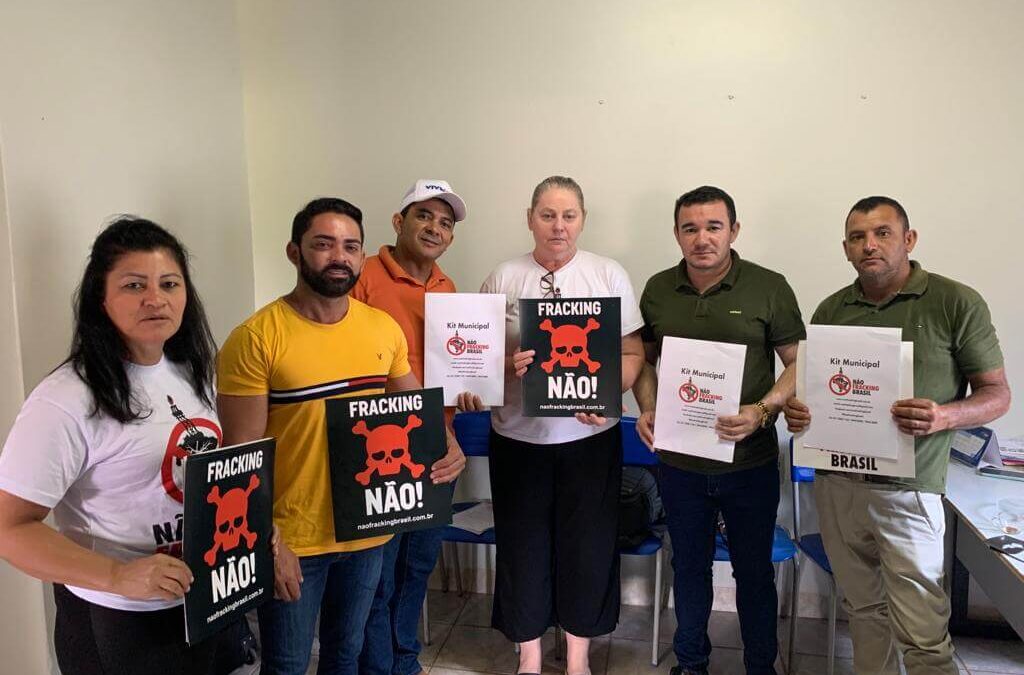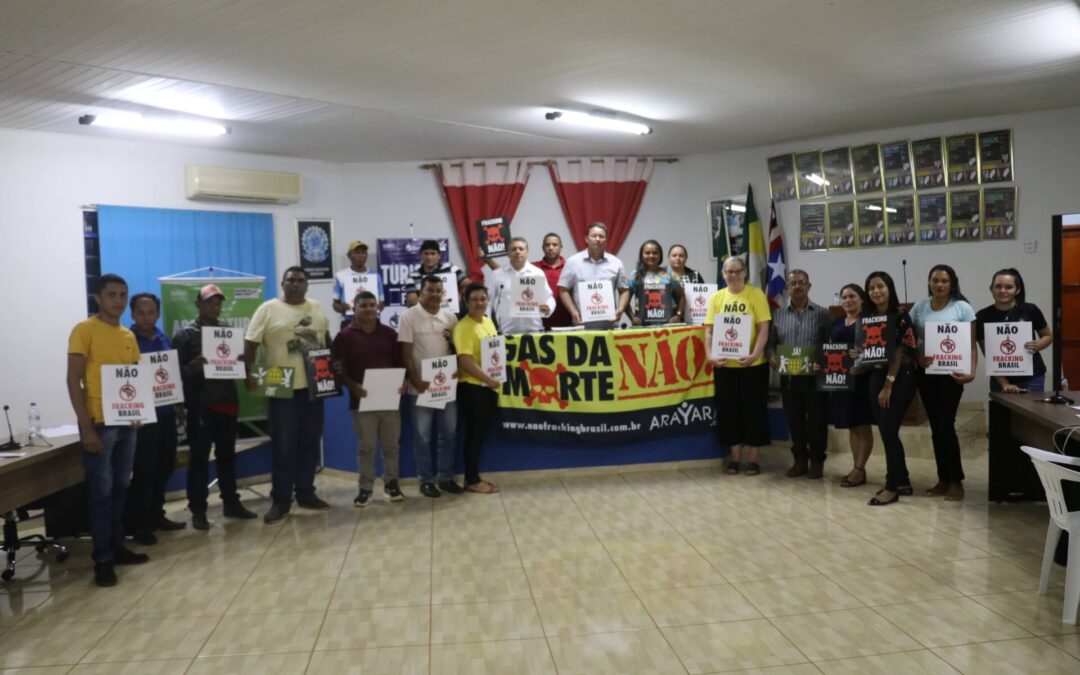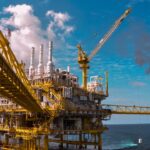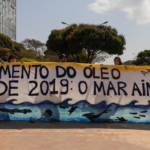
por Comunicação Arayara | 23, set, 2022 | Fracking |
Group of city councilors received the Coalition No Fracking Brazil for Water and Life for a conversation about the effects of the practice
What is fracking?
Fracking – also called hydraulic fracturing – is a process that involves injecting large volumes of water, chemicals and sand at high pressure into underground rock layers to release trapped natural gas. Despite being a technique already used in several countries, it is controversial because it causes environmental and ecological damage, including contamination of groundwater, release of greenhouse gases, induced earthquakes, etc.
The municipality of Riachão, in Maranhão, in the region of Chapada das Mesas, was visited by the team from COESUS – Coalition No Fracking Brazil for Water and Life, a campaign by the Arayara International Institute, on September 23, 2022. At the city hall councillors, a meeting was held with representatives of the local legislature, with the presence of the president of the house, Uelton Silva Canuto and councilors Welligton Alves Paz (known as Jaba), Edivan Oliveira da Silva (Edivan Paixão), Wanderson Moreira and Júnior dos Santos Pinto.
Aware of the negative impacts of fracking, the councilors undertook to deepen their studies on the subject and received a proposal for a municipal law that would make it difficult for oil companies to enter the exploration of shale gas through fracking in Riachão. Councilors said they were determined to take action to defend the municipality against the risks associated with this practice.
The presence of the COESUS team provided updated and scientifically based information on the impacts of fracking. During the meeting, studies and reports from other locations affected by this activity were shared, in order to make municipal representatives aware of the harmful effects on water, health, agriculture and the environment.

por Comunicação Arayara | 23, set, 2022 | Fracking |
The COESUS team made a speech at the invitation of parliamentarians from the city of Maranhão
What is fracking?
Fracking – also called hydraulic fracturing – is a process that involves injecting large volumes of water, chemicals and sand at high pressure into underground rock layers to release trapped natural gas. Despite being a technique already used in several countries, it is controversial because it causes environmental and ecological damage, including contamination of groundwater, release of greenhouse gases, induced earthquakes, etc.
The COESUS team – Coalition No Fracking Brazil for Water and Life, a campaign by the Arayara International Institute, was invited by the councilors of Novas Colinas, in Maranhão, to participate in a public session held at the City Council on September 23, 2022. The group shared information about the risks of exploiting shale gas using the fracking method in the municipalities of Maranhão. The plenary was attended by 8 councilors and more than 10 representatives of the local community.
The invitation was made after a conversation with the president of the Rural Union of Farmers and Farmers of Nova Colinas, Ivanete Carvalho da Silva, and other farmers linked to the body. The conversation dealt with the risks of hydraulic fracturing and, after that moment, one of the councilors present called the COESUS team to speak at the City Council.
During the session, all those present raised doubts and questioned the interests of the oil industry in relation to the exploitation of shale gas through fracking. The mayor asked several questions about the impacts, and the COESUS technician, Suelita Röcker, answered based on scientific studies and practical experiences.
At the end of the training, each councilor explained his views against fracking and reaffirmed his commitment to defending the life and well-being of the population. They pledged to present a law that would make it difficult for oil companies to explore fracking in the municipality.

por Comunicação Arayara | 23, set, 2022 | Fracking |
A equipe da COESUS fez uma fala a convite dos parlamentares da cidade maranhense
O que é o fracking?
O fracking – também chamado de fraturamento hidráulico – é um processo que envolve a injeção de grandes volumes de água, produtos químicos e areia, a alta pressão, em camadas de rocha do subsolo para liberar o gás natural que está preso. Apesar de ser uma técnica já utilizada em vários países, ela é controversa por causar danos ambientais e ecológicos, incluindo contaminação da água subterrânea, liberação de gases de efeito estufa, terremotos induzidos etc.
A equipe da COESUS – Coalizão Não Fracking Brasil pela Água e Vida, uma campanha do Instituto Internacional Arayara, foi convidada pelos vereadores de Novas Colinas, no Maranhão, para participar de uma sessão pública realizada na Câmara Municipal no dia 23 de setembro de 2022. O grupo compartilhou
informações sobre os riscos da exploração de gás de xisto pelo método de fracking nos municípios maranhenses. O plenário contava com a presença de 8 vereadores e mais de 10 representantes da comunidade local.
O convite foi feito após uma conversa com a presidente do Sindicato Rural de Agricultores e Agricultoras de Nova Colinas, Ivanete Carvalho da Silva, e outros agricultores ligados ao órgão. A conversa tratou sobre os riscos do fraturamento hidráulico e, após esse momento, um dos vereadores presentes chamou a equipe da COESUS para uma fala na Câmara Municipal.
Durante a sessão, todos os presentes levantaram dúvidas e questionaram os interesses da indústria petrolífera em relação à exploração do gás de xisto através do fracking. O presidente da Câmara Municipal realizou diversas perguntas sobre os impactos, e a técnica da COESUS, Suelita Röcker, respondeu com embasamentos em estudos científicos e experiências práticas.
Ao final da capacitação, cada vereador expôs suas colocações contra o fracking e reafirmou o compromisso de defender a vida e o bem-estar da população. Eles se comprometeram a apresentar uma lei que dificulte a entrada de empresas petrolíferas para a exploração de fracking no município.

por Comunicação Arayara | 12, set, 2022 | Fracking |
Concejales y vicealcalde de la ciudad maranhense afirman que las acciones de las compañías petroleras se llevaron a cabo de manera silenciosa
¿Qué es el fracking?
El fracking, también conocido como fracturamiento hidráulico, es un proceso que implica la inyección de grandes volúmenes de agua, productos químicos y arena a alta presión en capas de roca subterránea para liberar el gas natural atrapado. Aunque es una técnica utilizada en varios países, es controvertida debido a los daños ambientales y ecológicos que causa, como la contaminación de las aguas subterráneas, la liberación de gases de efecto invernadero, los terremotos inducidos, entre otros.
Parnarama, Maranhão, participó en una capacitación el 12 de septiembre de 2022 en el salón del Concejo Municipal que trató sobre los riesgos y problemas causados por el fracking. El evento contó con la presencia de concejales del municipio y de ciudades vecinas, representantes de los agentes comunitarios de salud, comunidades quilombolas y miembros del sindicato de trabajadores rurales. Además del vicealcalde y miembros de la sociedad civil, quienes siguieron atentamente la audiencia. También estuvieron presentes integrantes de COESUS – Coalición No al Fracking Brasil por el Agua y la Vida, una campaña del Instituto Internacional Arayara.
Después de la audiencia, los concejales se pronunciaron sobre las empresas que habían llevado a cabo investigaciones en el municipio durante la administración anterior. Informaron que un gran convoy compuesto por varias camionetas, jeeps y cinco camiones de nueve ejes, transportando equipos de perforación, recorrió la región. Los camiones transportaban los equipos, que fueron montados en un complejo que incluía contenedores para el alojamiento de los trabajadores, una ambulancia para casos de emergencia, grúas y otros equipos necesarios.
Según los concejales, todo el proceso se llevó a cabo rápidamente, sin consultar a la población. Uno de los concejales, que anteriormente no ocupaba un cargo público, informó que había cuestionado a uno de los empleados de la empresa, pero las respuestas fueron evasivas. “Así como llegaron y llevaron a cabo sus acciones, se fueron en silencio”.
El vicealcalde del municipio, Gilson Moura (Gilson Da Silva Leite), del PCdoB, informó al equipo de COESUS que había visto varios jeeps de la empresa circulando tanto por la ciudad como por las áreas rurales. Al abordarlos, no obtuvo ninguna explicación satisfactoria. Además, el vicealcalde informó que tanto él como el alcalde aprobarán una ley en contra de la técnica de fracturamiento hidráulico en el municipio.
La concejala Querida Moura (Eliane Geisteira de Moura Leite), del PP, afirmó estar al tanto de la presencia de los camiones y envió un video al equipo de COESUS, fechado el 18 de enero de 2008, que muestra la comunidad de Paiol do Centro, ubicada a 50 km de la sede municipal, durante una inundación. El video muestra una desbordamiento del río que se asemeja a una explosión, elevando el nivel del agua en 2 metros, según la concejala. El técnico Isaías Lima da Silva, de Trat’Água, estuvo presente en el lugar junto con profesores de la comunidad de Paiol do Centro.
Tres años antes del video, en el mismo lugar, 40 cabezas de ganado desaparecieron en el suelo como en un tipo de arena movediza. Intentaron rescatar algunos animales, pero estaban muertos. Se observaron varias grietas y una gran cavidad con agua en el lugar. Según la explicación del técnico responsable de la recolección de materiales en el lugar, las grietas y las cavidades son consecuencia de explosiones provocadas por la producción de gas carbónico, proveniente de un proceso natural de descomposición de materia orgánica de animales y plantas.
Este gas penetra en las grietas de las rocas y, en ausencia de oxígeno, se producen explosiones anaeróbicas, liberando el gas hacia la atmósfera. Como resultado, el suelo cede, causando grietas y cavidades. El técnico recomendó el aislamiento del área para evitar accidentes y afirmó que la cavidad podría tragarse el bosque circundante. Hasta el momento de la grabación del video, no se habían tomado medidas.
Estos eventos alarmantes evidencian la necesidad de un monitoreo y planificación cuidadosos de las actividades realizadas en el municipio, con el fin de proteger el medio ambiente, la población y la fauna local. Es fundamental que las autoridades locales estén atentas a los impactos potenciales de estas acciones y fomenten la participación de la comunidad en las decisiones que afectan directamente sus vidas y el ecosistema en el que están insertados.

por Comunicação Arayara | 12, set, 2022 | Fracking |
Councilors and deputy mayor of the Maranhão city say that the actions of oil companies were carried out silently
What is fracking?
Fracking – also called hydraulic fracturing – is a process that involves injecting large volumes of water, chemicals and sand at high pressure into underground rock layers to release trapped natural gas. Despite being a technique already used in several countries, it is controversial because it causes environmental and ecological damage, including contamination of groundwater, release of greenhouse gases, induced earthquakes, etc.
Parnarama, Maranhão, participated in a training session, on September 12, 2022, in the plenary of the City Council, which dealt with the risks and problems caused by fracking. The event was attended by councilors from the municipality and neighboring cities, representatives of community health agents, quilombolas and members of the rural workers’ union. In addition to the deputy mayor and members of civil society, who closely followed the hearing. In addition to members of COESUS – Coalition No Fracking Brazil for Water and Life, a campaign by the Arayara International Institute.
After the hearing, the councilors spoke about companies that had carried out research in the municipality during the previous administration. They reported that a large convoy consisting of several pickup trucks, jeeps and five nine-axle trucks carrying drilling equipment traveled through the region. The trucks transported the equipment, which was assembled in a complex containing overnight containers for employees, an ambulance for emergency cases, tow trucks and other necessary equipment.
According to the councilors, the whole process was carried out quickly, without consulting the population. One of the parliamentarians, who previously did not hold public office, reported having questioned one of the company’s employees, but the responses were evasive. “As soon as they arrived and performed their deeds, they departed in silence.”
The deputy mayor of the municipality, Gilson Moura (Gilson Da Silva Leite), from the PCdoB, reported to the COESUS team that he saw several company jeeps circulating both in the city and in rural areas. When approaching them, he did not obtain any satisfactory explanation. In addition, the deputy mayor informed that both he and the mayor will approve a law against the hydraulic fracturing technique in the municipality.
Councilor Querida Moura (Eliane Geisteira de Moura Leite), from the PP, stated that she was aware of the presence of the trucks and sent a video to the COESUS team, dated January 18, 2008, showing the community of Paiol do Centro, located 50 km from the municipal seat, during a flood. The video reveals an overflow of the river that resembles an explosion, raising the water level by 2 meters, according to the councilwoman. Technician Isaías Lima da Silva, from Trat’Água, was present at the site along with teachers from the community of Paiol do Centro.
Three years before the video, in the same location, 40 head of cattle disappeared to the ground in a kind of quicksand. They tried to rescue some animals, but they were lifeless. Several cracks and a large crater with water were observed at the site. According to the explanation of the technician responsible for collecting materials at the site, the cracks and craters are the result of explosions caused by the production of carbon dioxide, which comes from a natural process of decomposition of organic matter from animals and plants.
This gas penetrates the fissures of the rocks and, in the absence of oxygen, anaerobic explosions occur, releasing the gas into the atmosphere. As a result, the ground gives way, causing cracks and craters. The technician recommended isolating the area to avoid accidents and stated that the crater could swallow the forest around it. At the time of recording the video, no action had been taken.
These alarming events highlight the need for careful monitoring and planning of activities carried out in the municipality, in order to protect the environment, the population and the local fauna. It is essential that local authorities are aware of the potential impacts of these actions and promote community participation in decisions that directly affect their lives and the ecosystem in which they are inserted.









